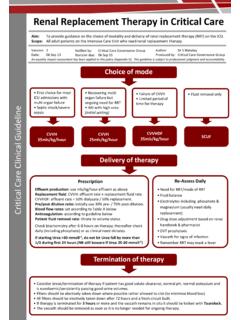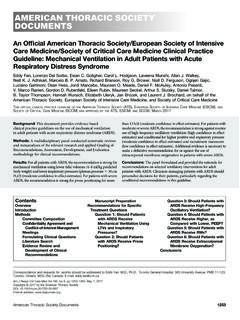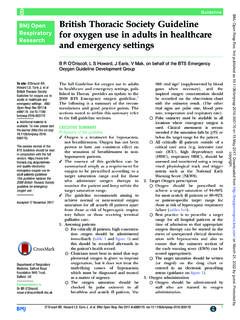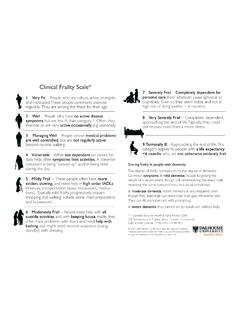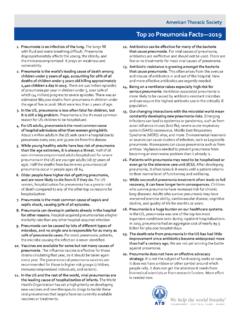Transcription of NHS STANDARD CONTRACT FOR SPECIALISED BURNS …
1 1 NHS England D06/S/a Gateway Reference 01364 NHS Commissioning Board, 2013 The NHS Commissioning Board is now known as NHS England D06/S/a NHS STANDARD CONTRACT FOR SPECIALISED BURNS care (ALL AGES) SCHEDULE 2 THE SERVICES A. SERVICE SPECIFICATIONS Service Specification No. D06/S/a Service SPECIALISED Burn care (All Ages) Commissioner Lead Provider Lead Period 12 months Date of Review 1. Population Needs National/local context and evidence base National Context The complexity and rarity of burn injuries makes delivering burn care a SPECIALISED service. Although significant advances have been made in burn care over recent decades, it is recognised that to achieve the best possible clinical outcome for burn injured patients, burn care must be delivered by expert multi-disciplinary teams in SPECIALISED burn services. Formal standardised processes, structures and agreed working practices are required to continue improving the survival rates and quality of life for patients who have sustained a burn injury [4].
2 Patients with burn injuries often present with unique clinical, psychological and social challenges; burn injury can be one of the most severe forms of trauma and therefore treatment in SPECIALISED services is required. 2 NHS England D06/S/a Gateway Reference 01364 NHS Commissioning Board, 2013 The NHS Commissioning Board is now known as NHS England Burn care services and burn care networks have developed organisational processes to meet the complex needs of these patients while at the same time ensuring care is delivered close to home as soon as possible. Approximately 130,000 people with burn injuries visit Emergency Departments (ED) each year [6] and approximately 10,000 are admitted to hospital [6]. Of these, approximately 500 are admitted to hospital with severe burn injuries which require fluid-resuscitation [22]. Approximately half of these are children under 16 years of age [22]. The majority of cases referred to SPECIALISED burn services will fall towards the lower end of the severity spectrum.
3 It must be remembered that such injuries require SPECIALISED care to achieve good outcomes, reduce long-term scarring and prevent other on- going problems. SPECIALISED burn services focus on the management of people with BURNS which require referral to and assessment by, a SPECIALISED burn service (in line with agreed National Referral Guidance [23]). Burn care activity is predominantly driven by emergency admissions (although there are a small number of elective cases for reconstructive surgery). The SPECIALISED care pathway (see Appendix A) involves immediate assessment and treatment, acute care , rehabilitation, surgical reconstruction and on-going community care to maximise recovery. In England and Wales burn care is organised using a tiered model of care [22] whereby the most severely injured are cared for in services recognised as Centres and those requiring less intensive clinical support being cared for in either a Unit or a Facility.
4 This provides a balance between easy access and care provided closer to home for the majority of patients with highly SPECIALISED , centralised services for a much smaller proportion of patients with more severe injuries. The report of the National Burn Review Committee (2001) [22] has defined national policy in this area since its publication. Aetiology and Epidemiology of Burn Injuries Burn injuries are largely non-intentional, caused by carelessness or inattention, pre-existing medical conditions (the presentation of which may be a collapse), or they may follow alcohol or drug abuse [7]. The most common location for burn injuries is the home and the most common cause of burn injury are scalds from hot drinks. The cohorts of patients at greatest risk of sustaining a burn injury are those in the lowest socio-economic groups. The most vulnerable groups in society are at greatest risk of having an accidental injury. Children and young men are more likely to suffer a burn injury than other age groups.
5 Social deprivation and population density are closely associated with the prevalence and incidence of BURNS [8-12]. According to the World Health Organisation, burn injuries occur disproportionately among racial and ethnic minorities as their often low socio-economic status increases the likelihood of people in these groups sustaining a burn injury [11]. 3 NHS England D06/S/a Gateway Reference 01364 NHS Commissioning Board, 2013 The NHS Commissioning Board is now known as NHS England There are an increasing number of older adults sustaining burn injuries because of the current trend associated with the ageing population [13]. There is a clinical consensus that older adults with burn injuries are complex to treat and are likely to have a prolonged length of hospital stay. For adult patients with burn injuries there is a strong positive correlation between age and mortality [14, 15]. People with burn injuries have an increased likelihood of having pre-injury mental health issues as compared with the general population [16, 17].
6 A burn injury can have a variety of aetiologies such as thermal (flash, contact, scald, radiation), electrical (low voltage, high voltage) and chemical (acid, alkali) [18]. There are also a number of rare skin-loss conditions which can cause massive burn-like wounds and symptoms which may best be treated within a SPECIALISED burn service [19, 20]. The severity of a burn is dependent on the size and anatomical site of the injury, the depth of the burn, the age of the patient, the presence of an inhalation injury and other significant co-morbidities. All of these factors will influence morbidity and mortality. The severity of a burn is usually described in terms of depth and percentage total body surface area (%TBSA). Initial assessment and management by professionals with experience in burn care and experience and training in acute burn management will reduce the risk of potentially life or limb threatening conditions not being recognised [7].
7 Burn injuries can have a significant, sustained and profound physical, psychological and social effect on the patient, family and carers. The physical damage to tissue and the physiological effect caused by the agents involved will affect the function and appearance of the tissue and limbs. This coupled with the psychological effects of having had a burn injury can also influence the psychological and social wellbeing of the patient. The physical and psychological consequence of a burn injury are not always dependent on the severity or site of the injury. Infection is a major complication of burn injury. Infection is linked to impaired resistance from disruption of the skin's mechanical integrity and generalised immune suppression. Stewardship of antibiotic antiseptic use to reduce infection risk is therefore paramount. Key factors (relating to treatment) that impact on burn outcomes include early fluid resuscitation, prompt wound care , and timely access to effective surgical and therapeutic management (including surgical excision).
8 Evidence Base MTG2: MoorLDI2-BI: a laser doppler blood flow imager for burn wound assessment 4 NHS England D06/S/a Gateway Reference 01364 NHS Commissioning Board, 2013 The NHS Commissioning Board is now known as NHS England 2. Outcomes NHS Outcomes Framework Domains & Indicators (Appendix 1) Domain 1 Preventing people from dying prematurely Domain 2 Enhancing quality of life for people with long-term conditions Domain 3 Helping people to recover from episodes of ill-health or following injury Domain 4 Ensuring people have a positive experience of care Domain 5 Treating and caring for people in safe environment and protecting them from avoidable harm The service will complete/update the nationally agreed Quality Dashboard for SPECIALISED burn care services. For 2013/14 these outcome measures relate to: IBID Data Completeness Compliance with National Referral Guidance Surgical Management - Assessment of resus BURNS by a BURNS consultant within 12 hours of admission Adequate Analgesia given Timely Healing Optimising psychological well-being Optimising Functional Outcome 3.
9 Scope Aims and objectives of service SPECIALISED burn care services aim to reduce mortality and optimise both 5 NHS England D06/S/a Gateway Reference 01364 NHS Commissioning Board, 2013 The NHS Commissioning Board is now known as NHS England physical and psychological outcomes following burn injury. The above aim will be achieved by: Delivering treatment and care that conforms to national standards and published clinical guidelines Being responsive to the psychological needs of patients and their families Delivering care holistically, ensuring that all patients have access to a wide range of specialist multi-disciplinary services Encouraging an environment in which patients and families are able to make informed decisions about their treatment Facilitating on-going care as near to the patient s own community where clinically appropriate Delivering the appropriate elements of specialist burn care treatment as part of a recognised managed clinical network Ensuring equity of access to SPECIALISED burn care for adults and children Responding effectively to major incidents involving a significant number of burn casualties [3] Service description/ care pathway Service Delivery SPECIALISED burn care services provide.
10 Assessment acute care (including actual care and surgical care ) rehabilitation surgical reconstruction on-going follow-up care To patients with burn injuries that are too complex or severe to be appropriately cared for by community services or District General Hospitals. In England and Wales SPECIALISED burn care is organised using a tiered model of care (Centre, Unit and Facility) whereby the most severely injured are cared for in services recognised as Centres, those requiring less intensive clinical support are cared for in services recognised as Units, and those with non- complex burn injuries can be cared for in services recognised as facilities. The aim of the tiered model is to utilise resource and expertise optimally. A burn care service at a given level will also provide a lower level service to its local population (for example an adult Burn Centre will also provide an adult Unit and Facility level service).










